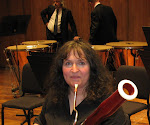For some reason, musicians often expect to be less challenged for concerts such as Pops and YPCs. That expectation obviously is unwarranted. There are few (if any) works in the orchestral repertoire more difficult for bassoon, technically speaking, than New England Tryptich. While it may seem impossible to perfectly execute this particular bassoon part, there's no doubt that we can take steps to improve our odds of coming out of it relatively unscathed.
All of the 16th notes pictured above are exposed. The repeated figure at measure 40 is one that I spent a lot of time on. As a rule, I try to use full standard fingerings, so my left thumb automatically insists upon depressing the whisper key for the G3s in that figure. Fortunately, the whisper key is not really mandatory here, and my first challenge is trying to talk my thumb out of using that whisper key! The passage is much more likely to be successfully executed if the left thumb remains up near the high D and C keys. I use the high D key to play C4 (some bassoonists use the high C key), and of course I use the high C key for B4. I have found that it is the A3 which causes the biggest problem, with the left thumb having to move to and from the A and C# keys together. To practice this, I isolate the 4 notes, with added emphasis (length) on the A3 in the attempt to train the left thumb to navigate reliably from the high C key to the high A and C# keys required for A3.:

I practice this repeated figure all slurred, at whatever tempo I'm able to play it accurately, and once it seems to be mastered at that tempo, I increase the tempo slightly, and so on until (hopefully) I'm in the vicinity of 160.
The passage at measure 60 involving A3, B4, C#4 and D4 is so outrageously difficult at 160 to the quarter note that fake fingerings offer our only hope! For the interval B4 to C#4 I keep the B fingering intact and raise the 1st and 2nd fingers of the left hand and the 1st and 2nd fingers of the right hand all at once. The fake C# comes out too flat, so the embouchure has to be used to try to squeeze up the pitch. The High C# trill works well with trilling the 1st fingers of both hands simultaneously.
In addition to careful preparation, a good dose of luck is most helpful! I'm hoping to have a good day tomorrow......
.





4 comments:
Good luck for the concert.
Had a go at this myself - ouch! Tricky little blighter.
Dear PSFT,
You know, it wouldn't be so bad if it weren't for the tempo! The concert is now over, and I think it went OK. Now on to Bartok Concerto for Orchestra, Marriage of Figaro Overture and Brahms Piano Concerto No. 1 tomorrow!
Betsy
Our community orchestra did this in March. Never have so few measures received so much practice.
Dear Rantmaster Rich,
Well, it sounds as though you gave it your very best shot. That's all we can do!! And everything else seems easy now....
Betsy
Post a Comment